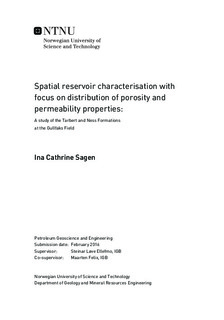Spatial reservoir characterisation with focus on distribution of porosity and permeability properties: - A study of the Tarbert and Ness Formations at the Gullfaks Field
Master thesis
Permanent lenke
http://hdl.handle.net/11250/2389109Utgivelsesdato
2016Metadata
Vis full innførselSamlinger
Sammendrag
This thesis aims to characterise the spatial petrophysical distribution of porosity and permeability properties in the Tarbert and Ness Formation at the Gullfaks Field. The geomodelling software Leapfrog Geo was used to build a reservoir model and estimate the spatial petrophysical properties. Four different procedures were used to obtain the results; the Geological Model (GM), the Geological Model Fault Block 2 (GM Fault Block 2), petrophysical model of the Geological Model (GM) volume and petrophysical model of the Geological model Fault Block 2 (GM Fault Block 2) volume.
The results showed that Leapfrog Geo is suitable to characterise petrophysical properties in a reservoir model where the main data source is well data. However, with additional data sources, are probably other types of software preferable. The radial basic function (RBF) is suitable to interpolate and estimate fault iso-surfaces and petrophysical data. However, not formation iso-surfaces that had to be triangulated. The Geological Model Fault Block2 (GM Fault Block 2) volume procedure yielded the best result, because of the good volume control both within the fault block and the formations. A 40m x 40m x 10m grid cell size yielded the best result and grid cell size is constrained both by smoothness and computer power.
